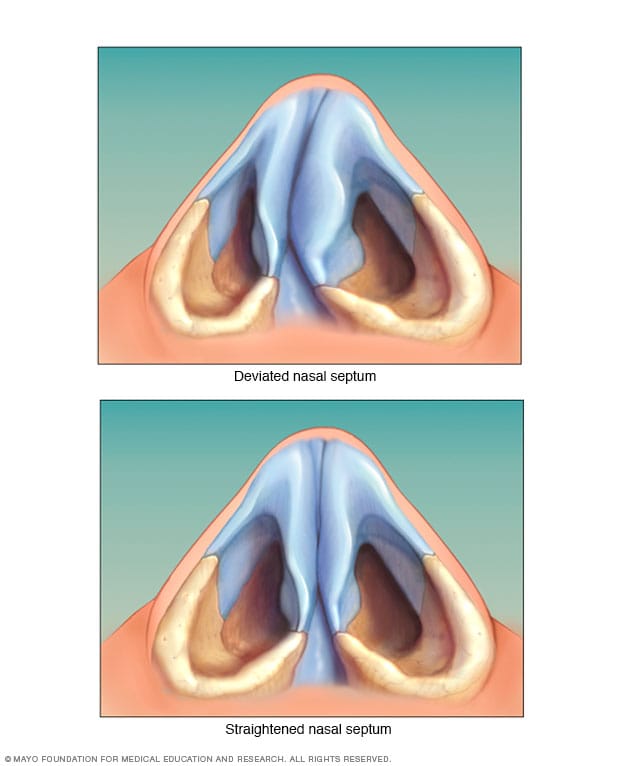
What is septoplasty?
The septum is the wall of bone and cartilage that divides your nose into two separate nostrils. A deviated septum occurs when your septum is moved to one side of your nose.
Some people are born with a deviated septum, but it can also be caused by an injury to your nose. Most people with a deviated septum have one nasal passage that’s much smaller than the other. This can cause difficulty breathing. Other symptoms of a deviated septum may include frequent nosebleeds and facial pain. Surgery is the only way to fix a deviated septum.
Septoplasty is a surgical procedure to correct a deviated septum. Septoplasty straightens the septum, allowing for better airflow through your nose.
 Deviated septumOpen pop-up dialog box
Deviated septumOpen pop-up dialog box
A crooked septum is common. But when it’s severe, a deviated septum can block one side of your nose and reduce airflow, causing difficulty breathing through one or both sides of your nose.
Septoplasty straightens the nasal septum by trimming, repositioning and replacing cartilage, bone or both.
If you experience symptoms — such as difficulty breathing through your nose — that affect your quality of life, you may consider surgery to fix a deviated septum.
Before scheduling septoplasty, you’ll meet with your surgeon to discuss benefits and risks of the surgery. This meeting generally includes:
Avoid medications containing aspirin or ibuprofen (Advil, Motrin IB, others) before and after surgery. These medications may increase bleeding. Take only those medications approved or prescribed by your surgeon.
If you smoke, stop smoking. Smoking increases your risk of having problems during and after surgery. Smoking can slow the healing process.
Septoplasty straightens the nasal septum by trimming, repositioning and replacing cartilage or bone. The surgeon works through incisions inside the nose. Occasionally it is necessary to make a small incision between the nostrils.
If the nasal bones are crooked and pushing the septum off to one side, it may be necessary to make cuts in the bones of the nose to reposition them. Spreader grafts are small, reinforcing strips of cartilage that can be used to help correct a deviated septum when the problem is along the bridge of the nose. Sometimes these are necessary to effectively straighten the septum.
The procedure may be done with general anesthesia.
During surgery, the incision is closed with absorbable suture. Soft silicone splints may be inserted inside each nostril to support the septum. To prevent postoperative bleeding, your doctor may place bandage-like material in your nose (packing).
After surgery, you’re moved to a recovery room, where the staff monitors you and watches for any complications. This procedure is typically performed on an outpatient basis, so you’ll likely be able to go home the same day. You will need someone to drive you home, however.

To further decrease the chances of bleeding and swelling, your doctor may ask that you follow these precautions for several weeks after surgery. Depending on the extent of your surgery, you may not need to do all of these:
Most people find that septoplasty improves their symptoms, such as difficulty breathing, that were caused by a deviated septum. The level of improvement you can expect with septoplasty varies by person.
Dear All
In view of the COVID 19 attack, we at Suman Clinic want to initiate online consults which will benefit our patient’s Consultants available for online consultation except for Sundays.
Steps to follow